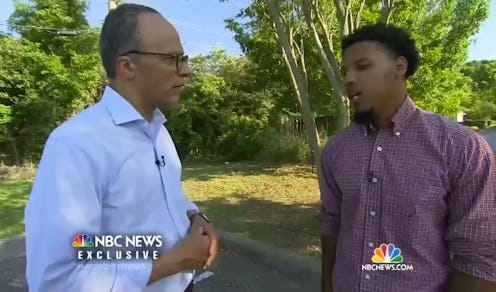News
You Are Totally Allowed To Video The Police

On Thursday evening, Feidin Santana, the man who filmed the North Charleston shooting of Walter Scott by police officer Michael Slager, gave an interview with CNN’s Anderson Cooper. Santana was walking to work Saturday when he noticed the commotion, and proceeded to capture the event on his mobile phone’s video camera. As he did so, Santana told Cooper, another officer told him to stop filming. The request begs the question: Is it illegal to video the cops? And if not, what are the legal parameters for recording their actions?
The video that Santana captured seems to show Slager shooting Scott eight times in the back as the latter ran away, after Scott was stopped for a broken brake light. Santana provided the video to the Scott family, and Slager has since been charged with murder and fired from the police force. Legal experts, having viewed the footage, opined to the New York Times that Slager’s actions were not justified. But what about Santana, and other citizen video-ers of the police — the bystander who filmed Eric Garner’s chokehold for instance?
Disturbing eyewitness videos of police actions, made simple by the advent of the smart phone, have ramped up the national debate on police tactics. And it turns out, bystanders like Santana are perfectly within their rights to film the police, regardless of whether the officers present appreciate it or not. Although, of course, there are some caveats.
The American Civil Liberties Union clearly outlines your rights when it comes to taking photographs or videos. Their website states:
Taking photographs of things that are plainly visible from public spaces is a constitutional right — and that includes federal buildings, transportation facilities, and police and other government officials carrying out their duties.
“Unfortunately,” the ACLU continues, “there is a widespread, continuing pattern of law enforcement officers ordering people to stop taking photographs from public places, and harassing, detaining and arresting those who fail to comply.” Never fear, Santana, you’re clearly not alone. On May 12, 2011, for instance, a woman in Rochester was illegally detained after she taped a traffic stop in front of her home. A website entitled “Photography Is Not A Crime” is dedicated to chronicling such incidents. Reporters in the Ferguson protests were also detained, possibly for the same reason (they were never charged, but had been filming police officers).
The ACLU further breaks down your rights, which amount to: if you’re in a public space, and “lawfully present,” you can photograph anything in plain view. On private property, however, the property owner can set their own rules about recording. The police meanwhile, are not lawfully enabled to confiscate or demand to view your photographs or videos unless they have a warrant. Even once you’ve been arrested, the Supreme Court has ruled that the police must get a warrant before examining the contents of your devices. The police are not permitted to delete videos or photographs under any circumstances — and are liable to face felony charges if they do so.
On the other hand, if your actions are actually interfering with a legitimate law enforcement operation, the police are legally empowered to order you to stop. Problematically, the crucial word here is “interfering,” and exactly what “interfering” means is not completely crystal clear. But as Mickey Osterreicher, an attorney for the National Press Photographers Association, told The Huffington Post, “There are First Amendment protections for people photographing and recording in public.” You simply have to keep out of the police officers’ way, and abide by the law.
But this is seemingly not a right all police officers champion. In August last year, the New York Police Department apparently felt the need to remind their officers of the laws regarding citizen videography. The NYPD circulated a memo, according to the New York Daily News, which read:
Members of the public are legally allowed to record police interactions… Intentional interference such as blocking or obstructing cameras or ordering the person to cease constitutes censorship and also violates the First Amendment.
As HuffPo points out, some states do prohibit the audio recording of private conversations without consent. But any attempt to limit individuals’ freedom to record is met with heavy scrutiny. Last year, Illinois tried to pass an eavesdropping law, which — although not prohibiting the filming of cops in public places — would have criminalized many other recordings. The law was swiftly struck down by the Supreme Court as unconstitutional.
So go forth and film, happy in the knowledge that you are doing so legally. And that your actions, like Santana’s, might make all the difference. To make matters even easier, Gizmodo has put together a list, the “Seven Rules for Recording Police,” that will help you to limit your exposure. They advise that you know the law (particular to your state, since some have more stringent audio recording laws), video or photograph openly (no secret filming!), respond to the cops’ comments and assert your rights (as Santana claims he did), don’t show the police your video, prepare to be arrested, master the technology, and DON’T point the recording device like a gun.
Clearly that last would be a bad call. On the “mastering the technology” front, Santana seems to have it down. He told MSNBC, “I was just witnessing it with my eyes and letting the phone do the work.” But for those less technologically gifted, there are even a bunch of apps springing up to help bystanders to capture police wrongdoing.
Images: NBC News (1); Getty Images (4)